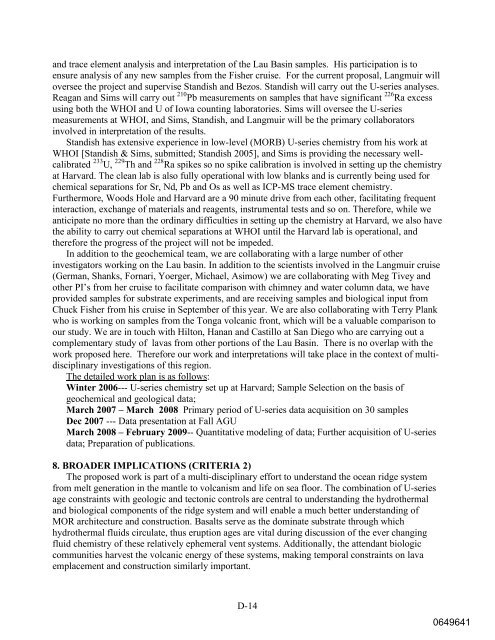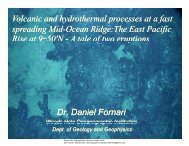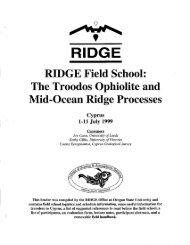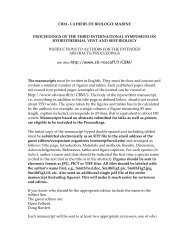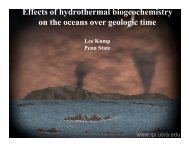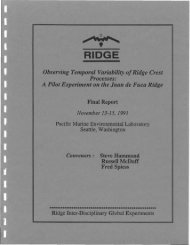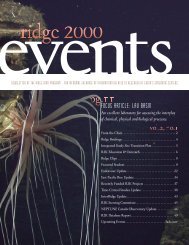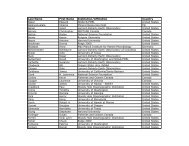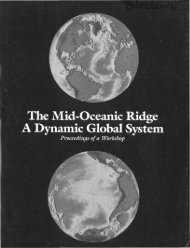NSF Forms - Ridge 2000 Program
NSF Forms - Ridge 2000 Program
NSF Forms - Ridge 2000 Program
Create successful ePaper yourself
Turn your PDF publications into a flip-book with our unique Google optimized e-Paper software.
and trace element analysis and interpretation of the Lau Basin samples. His participation is to<br />
ensure analysis of any new samples from the Fisher cruise. For the current proposal, Langmuir will<br />
oversee the project and supervise Standish and Bezos. Standish will carry out the U-series analyses.<br />
Reagan and Sims will carry out 210 Pb measurements on samples that have significant 226 Ra excess<br />
using both the WHOI and U of Iowa counting laboratories. Sims will oversee the U-series<br />
measurements at WHOI, and Sims, Standish, and Langmuir will be the primary collaborators<br />
involved in interpretation of the results.<br />
Standish has extensive experience in low-level (MORB) U-series chemistry from his work at<br />
WHOI [Standish & Sims, submitted; Standish 2005], and Sims is providing the necessary wellcalibrated<br />
233 U, 229 Th and 228 Ra spikes so no spike calibration is involved in setting up the chemistry<br />
at Harvard. The clean lab is also fully operational with low blanks and is currently being used for<br />
chemical separations for Sr, Nd, Pb and Os as well as ICP-MS trace element chemistry.<br />
Furthermore, Woods Hole and Harvard are a 90 minute drive from each other, facilitating frequent<br />
interaction, exchange of materials and reagents, instrumental tests and so on. Therefore, while we<br />
anticipate no more than the ordinary difficulties in setting up the chemistry at Harvard, we also have<br />
the ability to carry out chemical separations at WHOI until the Harvard lab is operational, and<br />
therefore the progress of the project will not be impeded.<br />
In addition to the geochemical team, we are collaborating with a large number of other<br />
investigators working on the Lau basin. In addition to the scientists involved in the Langmuir cruise<br />
(German, Shanks, Fornari, Yoerger, Michael, Asimow) we are collaborating with Meg Tivey and<br />
other PI’s from her cruise to facilitate comparison with chimney and water column data, we have<br />
provided samples for substrate experiments, and are receiving samples and biological input from<br />
Chuck Fisher from his cruise in September of this year. We are also collaborating with Terry Plank<br />
who is working on samples from the Tonga volcanic front, which will be a valuable comparison to<br />
our study. We are in touch with Hilton, Hanan and Castillo at San Diego who are carrying out a<br />
complementary study of lavas from other portions of the Lau Basin. There is no overlap with the<br />
work proposed here. Therefore our work and interpretations will take place in the context of multidisciplinary<br />
investigations of this region.<br />
The detailed work plan is as follows:<br />
Winter 2006--- U-series chemistry set up at Harvard; Sample Selection on the basis of<br />
geochemical and geological data;<br />
March 2007 – March 2008 Primary period of U-series data acquisition on 30 samples<br />
Dec 2007 --- Data presentation at Fall AGU<br />
March 2008 – February 2009-- Quantitative modeling of data; Further acquisition of U-series<br />
data; Preparation of publications.<br />
8. BROADER IMPLICATIONS (CRITERIA 2)<br />
The proposed work is part of a multi-disciplinary effort to understand the ocean ridge system<br />
from melt generation in the mantle to volcanism and life on sea floor. The combination of U-series<br />
age constraints with geologic and tectonic controls are central to understanding the hydrothermal<br />
and biological components of the ridge system and will enable a much better understanding of<br />
MOR architecture and construction. Basalts serve as the dominate substrate through which<br />
hydrothermal fluids circulate, thus eruption ages are vital during discussion of the ever changing<br />
fluid chemistry of these relatively ephemeral vent systems. Additionally, the attendant biologic<br />
communities harvest the volcanic energy of these systems, making temporal constraints on lava<br />
emplacement and construction similarly important.<br />
D-14<br />
0649641


